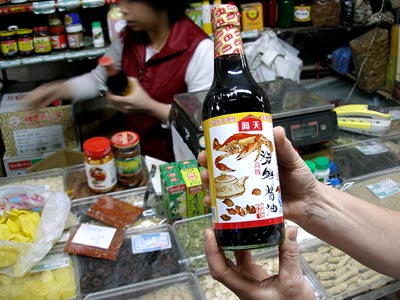Soya (US: soy sauce) is a dark sauce made from soya beans mixed with kōji, Aspergillus oryzae or Aspergillus sojae moulds, salt and water and then fermented. Japanese soya sauce and Indonesian are likely to be brewed with up to 50% of wheat grains, which may also be roasted. Chinese soya sauces are inclined to have less grain.
Light soya sauce, the one we most use in the West, is generally used for seasoning, that is for sprinkling onto a dish at the table. It is saltier and lighter in consistency than dark soya sauce and comes from early pressings of the mash. Touchōu in China is the very first pressing of the bean mash. As with extra virgin olive oil, this is regarded as higher quality and is sold for a higher price and is primarily used for dipping. There is another, double fermented first pressing soya sauce called shuānghuáng and which is also used for dipping.
Dark soya sauce is the liquid from the second pressing of the bean mash and has added molasses. It is darker and thicker than the light soya sauce and is more frequently used during the cooking process, as it is also more robust, but may also be added as a seasoning. soya sauce is widely used as a particularly important flavoring in Japanese, Thai, Korean, and Chinese cuisine. It is used as the equivalent of salt in the western cuisine. Despite their rather similar appearance, soya sauces produced in different cultures and regions are different in taste, consistency, fragrance and saltiness.
Traditionally the brewing, fermenting the mixture, pressing the liquids from the remaining cake (used as animal feed), and then further brewing of the mix before putting in barrels took around 3 months. I visited such a production unit in the 1970’s in Malaysia and was fascinated by the blackened interiors of the great tanks in which the mixture was brewed and the wonderful smell. Nowadays things are done under much more controlled arrangements.
